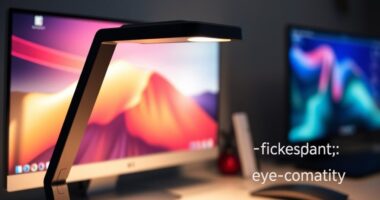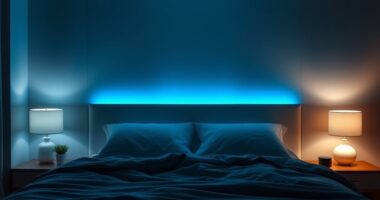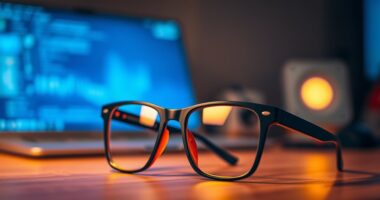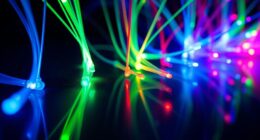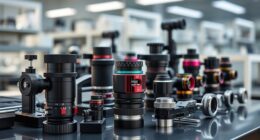Red light therapy, or photobiomodulation, can indeed speed up muscle recovery by stimulating cellular energy production and reducing inflammation. It works by interacting with your cells’ mitochondria, boosting ATP levels, and triggering repair processes. Scientific studies support its effectiveness for decreasing soreness and improving healing, especially in superficial muscles. While more research is ongoing, many users find it a safe, non-invasive way to enhance recovery. Keep exploring to discover how you can maximize these benefits for your muscles.
Key Takeaways
- Red light therapy stimulates mitochondrial activity, increasing ATP production to enhance muscle repair.
- Scientific evidence shows red light reduces inflammation markers, aiding faster muscle recovery.
- Consistent use improves cellular functions, promoting tissue regeneration and decreasing soreness post-exercise.
- Effectiveness depends on proper wavelength, session duration, and targeted application on superficial muscles.
- While promising, more rigorous research is needed to confirm long-term benefits and standardized protocols.
Understanding Photobiomodulation and Its Mechanisms
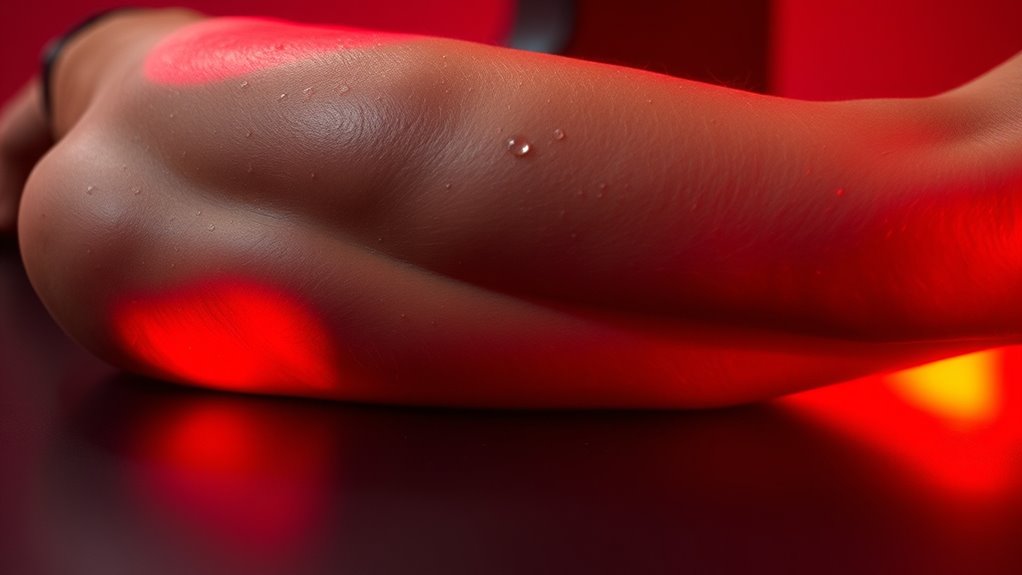
Photobiomodulation is a therapeutic technique that uses specific wavelengths of light to stimulate cellular function and promote healing. Its mechanisms involve light penetrating tissues and interacting with cellular components, especially mitochondria. This interaction enhances cellular signaling pathways, leading to increased production of ATP, the energy currency of cells. As a result, cells become more efficient at repairing damage, reducing inflammation, and restoring normal function. The process also influences reactive oxygen species and nitric oxide levels, which further modulate cellular responses. Fundamentally, photobiomodulation triggers a cascade of cellular signaling events that boost tissue recovery and reduce pain. Additionally, understanding the trustworthiness of Patchology can help ensure that the skincare products used alongside light therapy are safe and effective. By understanding these mechanisms, you can see how light therapy influences cellular behavior, making it a promising tool for accelerating muscle recovery and healing.
Scientific Evidence Supporting Red Light Therapy for Recovery

Research shows that red light therapy can lower inflammation markers, helping your body recover faster. It also boosts mitochondrial function, giving your cells more energy to repair and rebuild. These scientific findings support red light therapy as an effective recovery tool.
Reduced Inflammation Markers
Numerous studies show that red light therapy can markedly reduce inflammation markers, which are key indicators of tissue recovery and healing. By lowering inflammation, you help mitigate oxidative stress, a major factor that impairs recovery and damages cells. Red light stimulates your immune response, promoting the production of anti-inflammatory cytokines and reducing pro-inflammatory ones. This balance supports faster tissue repair and lessens soreness after intense exercise. Scientific evidence indicates that consistent use of red light therapy leads to measurable decreases in markers like C-reactive protein and interleukin-6. Nail Tips As a result, your body can recover more efficiently, with less prolonged inflammation and discomfort. This makes red light therapy a promising tool for speeding up muscle recovery and restoring ideal function after physical exertion.
Enhanced Mitochondrial Function
When red light therapy is applied, it directly enhances mitochondrial function by stimulating the production of adenosine triphosphate (ATP), the energy currency of cells. This boost in energy production helps your muscles recover faster and maintain better elasticity. Increased ATP levels support cellular repair processes, reducing fatigue and soreness after workouts. As the mitochondria work more efficiently, your muscles become more resilient and responsive, aiding in quicker muscle recovery. Improved mitochondrial function also promotes better muscle elasticity, decreasing the risk of strains and injuries. Scientific studies show that red light therapy can effectively enhance mitochondrial activity, leading to increased energy availability at the cellular level. This, in turn, accelerates muscle healing and helps you regain strength more rapidly. Additionally, research into sound healing science suggests that combining red light therapy with soothing sound frequencies may further optimize recovery processes.
Potential Benefits and How It Works on Muscles
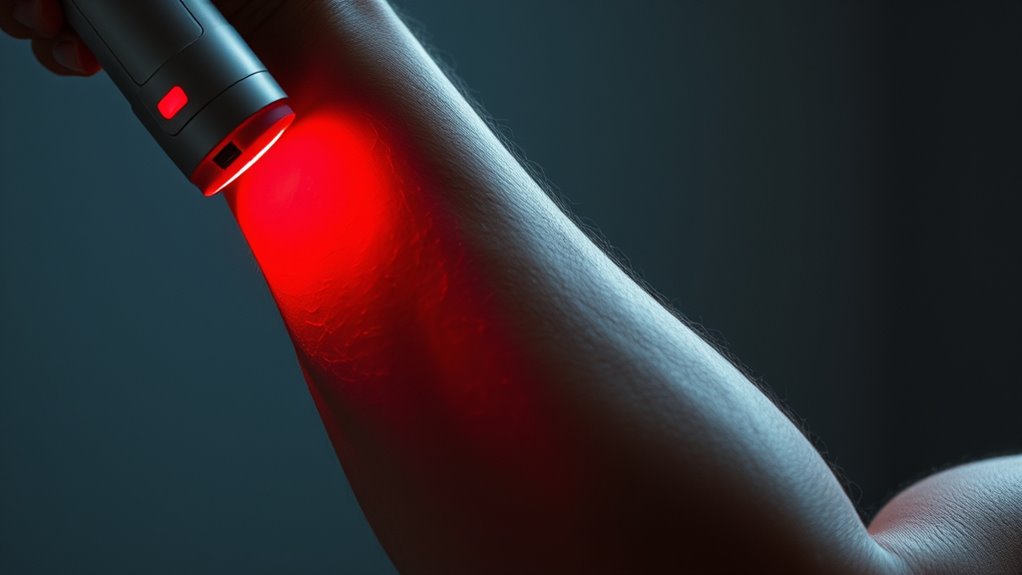
Photobiomodulation can enhance muscle function by stimulating cellular processes that promote healing and reduce inflammation. It boosts energy metabolism by increasing ATP production, fueling muscle cells for repair and growth. This process supports muscle hypertrophy by encouraging protein synthesis and cellular regeneration. The light penetrates tissues, activating mitochondria, and improving overall cellular efficiency. As a result, your muscles recover faster, experience less soreness, and perform better during workouts. The benefits extend to reducing oxidative stress and inflammation, which are common after intense activity. By improving energy flow within muscle cells, photobiomodulation helps optimize recovery and strength gains. Additionally, it can improve tissue health by supporting cellular repair mechanisms. This non-invasive technique offers a promising way to support muscle health, speed up recovery, and enhance physical performance without the need for pharmaceuticals or invasive procedures.
Limitations and Criticisms of Current Research
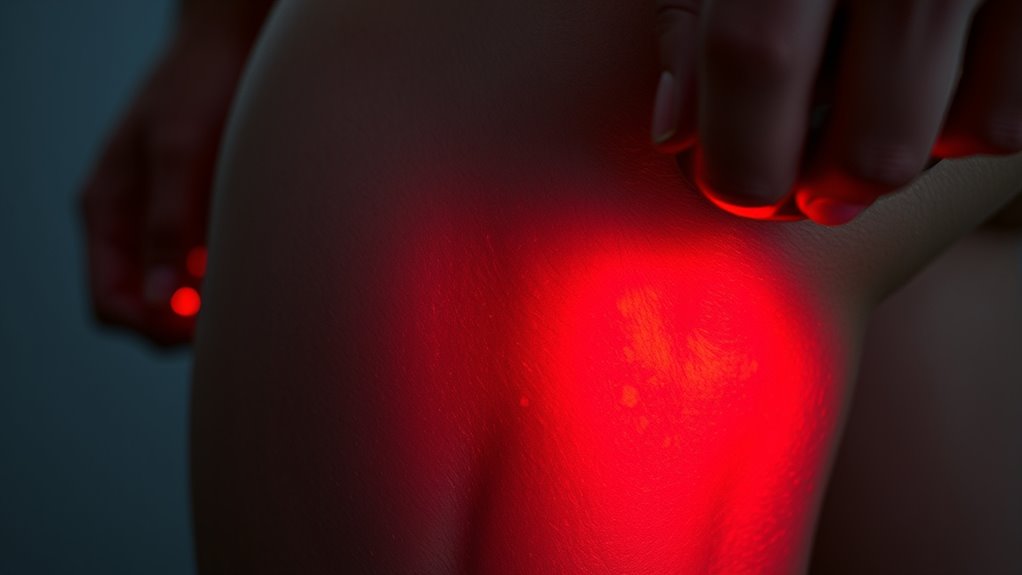
While promising, research on photobiomodulation’s effects on muscle recovery and performance still faces significant limitations. Many studies have small sample sizes, which makes it hard to draw definitive conclusions or generalize findings. Additionally, some research doesn’t adequately control for the placebo effect, leading to potential bias. When participants believe they’re receiving benefits, improvements might occur regardless of the actual treatment, skewing results. Variability in light dosages, wavelengths, and treatment protocols also complicates comparisons across studies. Without standardization and larger, well-controlled trials, it’s difficult to determine if red light truly accelerates recovery or if observed effects are due to other factors. Recognizing these limitations helps you interpret current findings with caution and underscores the need for more rigorous research. Furthermore, understanding divorce statistics can shed light on how legal and emotional factors influence outcomes for individuals undergoing significant life transitions.
Practical Tips for Incorporating Red Light Therapy

To get the most out of red light therapy, you should consider the best times to use it and how often. Focus treatment on specific areas that need improvement, and always follow safety guidelines. Understanding these practical tips helps you incorporate red light therapy effectively and safely into your routine. Additionally, paying attention to recommended products can enhance your experience and ensure you’re using high-quality equipment.
Optimal Timing Strategies
Timing your red light therapy sessions can considerably enhance their effectiveness. For ideal results, schedule sessions when your body is naturally more receptive, such as in the evening or post-workout. Improving sleep quality can boost recovery, so consider using red light therapy before bed to support restful sleep and muscle repair. Stay consistent with your routine, but avoid sessions too close to bedtime if you find it disrupts your sleep. Hydration strategies also play a role—drink plenty of water before and after treatments to help your body absorb the light benefits and facilitate recovery. By aligning your sessions with these factors, you maximize muscle repair and recovery, making your red light therapy more efficient and impactful.
Targeted Treatment Areas
Where should you focus red light therapy for targeted benefits? To optimize results, concentrate on specific muscle groups or areas needing recovery. Treatment customization is key—identify your problem spots, such as sore muscles or injury sites. When applying red light, consider light penetration; ensure the device’s wavelength and distance allow adequate depth to reach tissues effectively. For superficial muscles, closer proximity works well, while deeper tissues may require longer sessions or higher intensities. Consistency is vital—regular sessions on targeted areas can accelerate recovery and reduce soreness. Use a systematic approach, covering the entire affected region evenly. Additionally, selecting a Vetted device designed for effective light penetration can significantly enhance treatment outcomes. By focusing on the right areas and tailoring your treatment, you’ll enhance the benefits of red light therapy and support your muscle recovery goals more efficiently.
Safety and Precautions
When incorporating red light therapy into your routine, it’s important to prioritize safety to maximize benefits and minimize risks. Always follow dosage guidelines provided by the device manufacturer or a healthcare professional to avoid overexposure. Proper device safety is vital; ensure the equipment is certified and in good condition before use. Start with shorter sessions, gradually increasing duration as your body adapts. Keep the device at the recommended distance from your skin to prevent burns or discomfort. If you experience any irritation or unusual symptoms, discontinue use and consult a healthcare provider. Remember, red light therapy is a complement, not a replacement for medical advice. Being cautious with dosage and device safety helps you enjoy the potential benefits safely. Also, understanding 1023 Jack can provide additional context about safety considerations.
Future Directions and Ongoing Studies

As research into photobiomodulation advances, scientists are exploring new applications and refining treatment protocols to maximize its therapeutic potential. They focus on technological advancements that improve device precision, dosage control, and targeted delivery. These innovations help optimize outcomes for muscle recovery and other health benefits. Additionally, ongoing studies emphasize improving clinical trial design, ensuring rigorous standards and reliable results. Researchers are developing standardized protocols to better compare results across studies, which will accelerate acceptance and integration into mainstream medicine. Future directions include investigating long-term effects, combining photobiomodulation with other therapies, and exploring new wavelengths and parameters. Staying informed about research developments and emerging treatments will help you understand their potential to enhance recovery and overall health.
Frequently Asked Questions
Are There Any Known Side Effects of Red Light Therapy?
When considering red light therapy, you’re probably wondering about safety concerns and long-term effects. Generally, it’s safe when used properly, with minimal side effects like temporary redness or slight irritation. However, because long-term effects aren’t fully understood, it’s wise to consult a healthcare professional before regular use. Keep in mind that overexposure or improper settings could potentially cause harm, so follow recommended guidelines for safe, effective results.
How Does Red Light Compare to Other Recovery Methods?
Think of red light therapy as a shining star among recovery methods. When you compare its effectiveness, it often matches or exceeds traditional techniques like ice baths or massages. Plus, a clear cost-benefit analysis shows it’s affordable and easy to use. While results vary, many find red light a convenient, non-invasive way to boost healing, making it a compelling option in your recovery toolkit.
Can Red Light Therapy Replace Traditional Muscle Recovery Techniques?
You might wonder if red light therapy can replace traditional muscle recovery techniques. While it can reduce muscle soreness and potentially shorten your recovery timeline, it shouldn’t be your sole method. Combining red light with rest, proper nutrition, and stretching ensures ideal results. Think of red light as a helpful supplement, not a complete replacement, to enhance your recovery process effectively.
Is Red Light Therapy Effective for All Types of Muscle Injuries?
Did you know red light therapy shows promising results for muscle recovery? You should know that its effectiveness varies based on muscle specificity and injury severity. For minor strains, it can accelerate healing, but for severe injuries, its benefits are limited. So, while red light therapy may help in some cases, it’s not universally effective for all muscle injuries. Always consider injury type before relying solely on this treatment.
What Is the Optimal Wavelength and Duration for Muscle Recovery?
You should focus on wavelength precision and session duration to optimize muscle recovery. Typically, a wavelength around 630-670 nm is effective for penetrating tissues and promoting healing. Keep sessions brief, about 10-20 minutes, to prevent overstimulation and guarantee safety. Adjust the duration based on your response, but maintaining consistent, targeted therapy helps you maximize benefits and speeds up recovery effectively.
Conclusion
As you explore red light therapy, imagine a gentle glow wrapping your muscles like dawn’s first light, quietly speeding recovery. While science hints at its potential, it’s essential to stay informed and cautious, like steering a dawn that’s still unsure of itself. Keep an eye on ongoing research, and consider it as part of your recovery toolkit. With patience and awareness, you can let this promising light guide your muscles back to strength, naturally and effectively.


